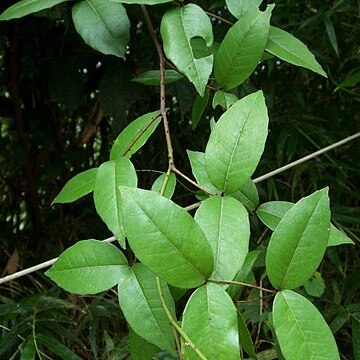Shrubs, erect or scrambling, or sometimes woody climbers. Trunk winged. Stems, branchlets, and leaf rachises usually with prickles. Rachis of inflorescences and abaxial surface of leaflet blades glabrous or hirsutulous. Leaves (3 or)5-11-foliolate; petiolules obsolete or to 5 mm; leaflet blades opposite, broadly ovate, subcordate, elliptic, narrowly elliptic, or rarely ovate, 3-12 × 1.5-6(-8) cm, leathery, secondary and tertiary veins abaxially ridged when dry, margin crenate at least toward apex or entire, apex acuminate to caudate with a retuse tip. Inflorescences axillary. Flowers 4-merous. Perianth in 2 series. Sepals ca. 1 mm wide, apically purplish green. Petals pale yellowish green, ovate-elliptic to oblong, ca. 3 mm. Stamens in male flowers 5-6 mm; mature anthers ellipsoid to globose. Petals in female flowers broader than those in male flowers. Gynoecium in female flowers 4-carpelled; carpels globose. Styles stout, coherent at anthesis; stigma capitate. Fruit pedicel 2-5 mm; follicles reddish brown, (5-)5.5-7 mm in diam., apex beaked. Fl. Mar-May, fr. Sep-Nov or May.
A shrub or scrambling vine. There are hooked thorns on the stems. Plants are separately male and female. The leaves are compound and alternate. Leaves are spiny underneath and also have small hairs. There are 5-9 leaflets and they are 5-10 cm long by 2-5 cm wide. A group of flowers occur in the axils of leaves or at the ends of branches. The flowers have 4 petals. They are cream, yellow or pink. They are 2 mm long. The fruit is a red follicle. It is 4-7 mm long and wide and has one seed. The seed is black and 4-5 mm long.


